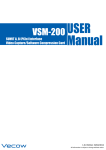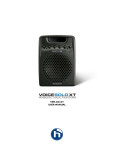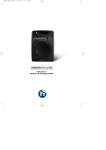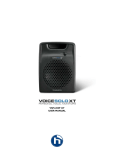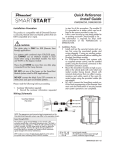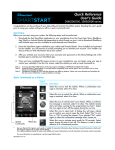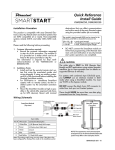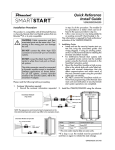Download Voice Solo XT VSM-200P XT User manual
Transcript
VSM-200 XT USER MANUAL IMPORTANT SAFETY INSTRUCTIONS The lightning flash with an arrowhead symbol within an equilateral triangle, is intended to alert the user to the presence of uninsulated “dangerous voltage” within the product’s enclosure that may be of sufficient magnitude to constitute a risk of electric shock to persons. The exclamation point within an equilateral triangle is intended to alert the user to the presence of important operating and maintenance (servicing) instructions in the literature accompanying the product. 1 2 3 4 5 6 7 8 9 Read these instructions. Keep these instructions. Heed all warnings. Follow all instructions. Do not use this apparatus near water. Clean only with dry cloth. Do not block any ventilation openings. Install in accordance with the manufacturer's instructions. Do not install near any heat sources such as radiators, heat registers, stoves, or other apparatus (including amplifiers) that produce heat. Do not defeat the safety purpose of the polarized or grounding-type plug. A polarized plug has two blades with one wider than the other. A grounding type plug has two blades and a third grounding prong. The wide blade or the third prong are provided for your safety. If the provided plug does not fit into your outlet, consult an electrician for replacement of the obsolete outlet. 10 Protect the power cord from being walked on or pinched particularly at plugs, convenience receptacles, and the point where they exit from the apparatus. 11 Only use attachments/accessories specified by the manufacturer. 12 Use only with the cart, stand, tripod, bracket, or table specified by the manufacturer, or sold with the apparatus. When a cart is used, use caution when moving the cart/apparatus combination to avoid injury from tip-over. 13 Unplug this apparatus during lightning storms or when unused for long periods of time. 14 Refer all servicing to qualified service personnel. Servicing is required when the apparatus has been damaged in any way, such as powersupply cord or plug is damaged, liquid has been spilled or objects have fallen into the apparatus, the apparatus has been exposed to rain or moisture, does not operate normally, or has been dropped. Warning! • To reduce the risk of fire or electrical shock, do not expose this equipment to dripping or splashing and ensure that no objects filled with liquids, such as vases, are placed on the equipment. • This apparatus must be earthed. • Use a three wire grounding type line cord like the one supplied with the product. • Be advised that different operating voltages require the use of different types of line cord and attachment plugs. • Check the voltage in your area and use the correct type. See table below: • • • • • Voltage Line plug according to standard. 110-125V UL817 and CSA C22.2 no 42. 220-230V CEE 7 page VII, SR section 107-2-D1/IEC 83 page C4. 240V BS 1363 of 1984. Specification for 13A fused plugs and switched and un-switched socket outlets. This equipment should be installed near the socket outlet and disconnection of the device should be easily accessible. To completely disconnect from AC mains, disconnect the power supply cord from the AC receptable. The mains plug of the power supply shall remain readily operable. Do not install in a confined space. Do not open the unit - risk of electric shock inside. Caution: You are cautioned that any change or modifications not expressly approved in this manual could void your authority to operate this equipment. Service • There are no user-serviceable parts inside. • All service must be performed by qualified personnel. a IMPORTANT SAFETY INSTRUCTIONS EMC / EMI. This equipment has been tested and found to comply with the limits for a Class B Digital device, pursuant to part 15 of the FCC rules. These limits are designed to provide reasonable protection against harmful interference in residential installations. This equipment generates, uses and can radiate radio frequency energy and, if not installed and used in accordance with the instructions, may cause harmful interference to radio communications. However, there is no guarantee that interference will not occur in a particular installation. If this equipment does cause harmful interference to radio or television reception, which can be determined by turning the equipment off and on. The user is encouraged to try to correct the interference by one or more of the following measures: • Reorient or relocate the receiving antenna. • Increase the separation between the equipment and receiver. • Connect the equipment into an outlet on a circuit different from that to which the receiver is connected. • Consult the dealer or an experienced radio/TV technician for help. For the customers in Canada: This Class B digital apparatus complies with Canadian ICES-003. Cet appareil numérique de la classe B est conforme à la norme NMB-003 du Canada. Certificate Of Conformity TC Electronic A/S, Sindalsvej 34, 8240 Risskov, Denmark, hereby declares on its own responsibility that the following product: VoiceSolo VSM-200 XT - Active Voice Monitor - is covered by this certificate and marked with CE-label conforms with following standards: EN 60065 Safety requirements for mains (IEC 60065) operated electronic and related apparatus for household and similar general use EN 55103-1 Product family standard for audio,video, audio-visual and entertainment lighting control apparatus for professional use. Part 1: Emission. EN 55103-2 Product family standard for audio, video, audio-visual and entertainment lighting control apparatus for professional use. Part 2: Immunity. With reference to regulations in following directives: 73/23/EEC, 89/336/EEC Issued in Risskov, 10 - 2007 Mads Peter Lübeck Chief Executive Officer b TABLE OF CONTENTS Table of Contents . . . . . . . . . . . . . . . . . . . . .3 Introduction . . . . . . . . . . . . . . . . . . . . . . . . .4 Front panel diagram . . . . . . . . . . . . . . . . . . .6 Back panel diagram . . . . . . . . . . . . . . . . . . .7 Mic stand mounting procedure . . . . . . . . . .8 Using VoiceSolo XT . . . . . . . . . . . . . . . . . .11 Setup diagrams . . . . . . . . . . . . . . . . . . . . .12 Specifications . . . . . . . . . . . . . . . . . . . . . .14 Specifications, interface, and features are subject to change without notice due to continued product improvement VoiceSolo VSM-200 XT Rev 1.0 English version Prod. no: 606120071 3 INTRODUCTION Welcome to VoiceSolo XT The TC-Helicon VoiceSolo XT VSM range of near field live monitoring speakers is a new concept in personal monitoring. TC-Helicon strives for excellence in all things related to vocals, and the VSM range builds upon the success and worldwide reputation of TC-Helicon's vocal expertise. If you can't hear yourself correctly in a live situation, it's hard to produce a good performance. VSM monitors are designed to integrate into a boom-style microphone stand bringing the speaker close to the performer. This yields a wide range of benefits over existing wedge-type or in-ear options such as: • Lower monitor bleed into the main PA sound • High volume level before feedback • Better interaction with audience; stage space is reclaimed from floor wedges and ear plug barriers are not required as in in-ear monitors. The VoiceSolo XT VSM monitors use a two-way point source ICT ™ driver that eliminates the problem of hearing separated high and low frequencies which happens when listening to conventional speaker systems. This is especially important when used on a microphone stand as the speaker is located very close to the listener and the separation would be more evident. VSM-200 XT Features: • Improved high frequency response in the critical 4 to 10 kHz range resulting in higher accuracy and smoother sound. • Quick mic stand set up. Integrates with Boom so the same stand is used for the monitor and microphone. • Versatile placement options provided by dual stand mounting holes and dual bevelled edges for floor mounting. • Two-way point source 6.5" ICT™ driver for optimal nearfield live monitoring. • High volume capability: 116dB peak SPL at .5m • 150W BASH amplifier. • Cast aluminum enclosure for maximum rigidity and minimum cabinet resonance • Front panel mounted volume control for easy access. • XLR or 1/4” input, line or mic level • Pass thru connection to PA 4 About TC-Helicon TC-Helicon’s core value is that the voice is the world's most beautiful instrument. Therefore, everything TCHelicon does is dedicated to this instrument. TC-Helicon envisions a world where those who work with voice are able to bring out its very best and where the possibilities of vocal craft are endless. The company's mission was galvanized by a simple question, "Isn't it time that someone finally provided dedicated tools and solutions for voice?" TC-Helicon is revolutionizing the vocal channel by providing innovative tools and solutions for people who create and work with the speaking and singing voice. Our customers include the most demanding of live performers, producers, broadcasters and recording engineers. Enjoy! The TC-Helicon Team a TC Group company INTRODUCTION Preliminary Recommendations The VoiceSolo XT VSM series of monitors are capable of very high sound pressure levels (SPLs) especially at the close range when integrated onto a microphone stand. They were designed this way to be able to be loud enough to compete with live acoustic drum kits. In situations where high monitoring volumes are required we recommend that ear protection be used. For continuous exposure we recommend the occasional use of a sound level meter capable of measuring the sound level over a period of exposure according to noise control standards. This should be used to check that noise levels are always within safety limits. Unpacking Open the box from the top and remove cabling. Lift out styrofoam insert, then using both hands lift out VoiceSolo XT. Remove plastic bag from VoiceSolo XT. Nothing in your speakers should rattle. Inspect each speaker for signs of transit damage. In the unlikely event of this having occurred inform the carrier and the supplier. Keep all the packaging if damage has occurred, as this will show evidence of excessive handling forces. It is also a good idea to keep the packaging if possible for future transportation. Registering VoiceSolo XT There are two methods for registering your VoiceSolo XT: • Online: visit www.tc-helicon.com/VoiceSolo and click Product Registration in the left hand column. • Mail: complete and return the registration card included with your product Support If you run into technical challenges, TC-Helicon will be more than happy to help. There are a number of sources for product support. We've prioritized them below according to the speed at which you will access the help information. 1. Manual: The manual for VoiceSolo VSM-200 XT is a good source of application information and in depth answers for common questions. 3. On-Line: visit www.tcsupport.tc to search and ask for answers on up to date questions about VoiceSolo XT. 4. Phone: International: +45 8742 7000 USA & Canada: 818-665-4900 5 FRONT PANEL DIAGRAM 2 4 1 3 1. CLIP led This led will light when the power amp is driven into limiting. Brief flashes now and then are OK. When the led is constantly lit however, you should lower the value of the Volume control. 2. Tuned bass port This allows VoiceSolo XT to produce low frequencies. It is also useful as a handle when carrying the unit. 3. VOLUME level control This controls the volume of the Mic or Line input. 4. POWER indicator This lights when power is applied. 6 BACK PANEL DIAGRAM 1 2 3 5 4 6 1. MIC Pass Thru jack Connecting an XLR cable here allows you to share your mic or line input with another device, typically a mixer or another VoiceSolo XT. 2. MIC IN jack Connect the XLR cable from your microphone here. If your mic requires phantom power, you will need to also connect a cable between VoiceSolo XT’s MIC THRU and a mixer or phantom power source. Engage the phantom power on the device after making the connections. 4. Power switch The | character represents power on, the O character represents power off. 5. AC power input Connect the standard IEC power cable that is included with VoiceSolo XT here. 6. Fuse holder The power amp is protected with this fuse. If the switch is on and VoiceSolo XT’s power led will not light, check the fuse here and only replace with the correctly rated part. 3. LINE IN jack You may connect a mono line level signal through this jack such as an acoustic/electric guitar, mono keyboard or an auxilliary send from your mixer. Note that this input is not suitable for amplifying high impedance sources such as electric guitars or non-preamplified acoustic pickups. You may connect either a mic or a line device to VSM-200 XT’s inputs but not both at once. The mic and line inputs are wired together and if used simultaneously the instrument connected to the line input will excite the mic’s diaphragm as if it were a speaker which could cause mic damage. 7 MIC STAND MOUNTING VoiceSolo XT Placement Options VoiceSolo XT can be placed in 4 different ways. This versatility allows you to use it as a mic stand mounted monitor one night, a PA system on another and then use it at home for practice or jamming. Mic Stand Mounting Mic Stand Integration What you need: • VoiceSolo XT • Tripod microphone stand with boom - must be the style where the boom may be unscrewed from the vertical shaft of the microphone stand. • VoiceSolo XT adaptor hardware including: Mic Boom Mount Attachment 1. Separate the boom from the stand by unscrewing the boom from the vertical shaft of the microphone stand. To do this, tighten the clutch you use to raise and lower the stand first. This makes it easier to unscrew the boom section. Hold the base of the stand with one hand and turn the boom counterclockwise (looking down from the top) with the other hand. 2. Screw the Mic Stand Mounting Insert on to the vertical shaft of the microphone stand. (If your stand has 3/8", European thread it will be necessary to use a 5/8" to 3/8" thread adapter, commonly included with both microphone stands and microphone clips) Mounting Insert Mic Stand Shaft Mic Stand Mounting insert * Tip: If you find that your VoiceSolo XT wobbles on the stand, try wrapping the Mic Stand Shaft threads with Teflon thread tape before screwing on the Mic Stand Mounting Insert. Teflon thread tape can be found at stores that sell plumbing supplies. 8 MIC STAND MOUNTING 3. Place VoiceSolo XT on the mic stand so the stand goes into the hole on the bottom of the VoiceSolo XT. If you don’t need to mount VoiceSolo XT on a boom stand, you are finished with your setup. If you require the boom, continue to the ne xt step. 5. Screw the Mic Boom Mount Attachment into your boom. 6. Lift the lid on VoiceSolo XT, and while holding it open, slide the Mic Boom Mount attachment, on the boom into slot on top of the monitor and let the lid close. 4. The Mic Boom Mount is found in the bag of parts that came with your VoiceSolo XT. There are two versions: a thin one for European stands and a wider one for the rest. This adapter connects the boom of your mic stand with VoiceSolo XT. It is designed to fit into the top receptacle in VoiceSolo XT. 9 MIC STAND MOUNTING 7. Your VoiceSolo XT should now look like this. 2. Still holding the boom so that it does not swing away, turn the lock nut counter-clockwise until it’s snug against the bottom of the boom. Note that it’s not possible to completely tighten the lock nut with your fingers, the final action is done by swinging the boom snug against the lock nut. Adjusting the Boom To optimize line-of-sight and audibility it is usually better to have the monitor situated somewhat beside the singer. To do this it is necessary to adjust the position of the boom. The steps required to adjust the position of the boom are as follows: 1. With the VoiceSolo XT integrated into the mic stand and boom, loosen the boom by rotating to the right while holding onto a corner of VoiceSolo XT. 3. After tightening the lock nut with your fingers, swing the boom left, tightening to the desired position. It may be necessary to go through steps 1 - 3 a few times to get the boom tightly where you want it. The boom must be tight or the weight of the mic can cause it to swing out of position. Read the ne xt section to learn how to connect your cables and power up VoiceSolo XT. 10 USING VOICESOLO XT Introduction The following paragraphs should be read at least once to learn more about safe and successful use of VoiceSolo XT. Hooking up AC power IMPORTANT - Before connecting the AC cable, confirm that the power specifications printed above the power input connector are correct for your area. VSM powered monitors do not feature automatic AC switching which is due to the high power to size ratio of BASH amplifiers. When you have confirmed that the AC standard is correct, turn the Power switch on VoiceSolo XT OFF and then plug the supplied AC cable from the input on VoiceSolo XT to a power receptacle. Good audio practice suggests that you always turn the front panel OUTPUT level all the way down before switching on power with the power switch. Now, apply power with the On/Off switch. The POWER led on the front panel will glow. If it doesn’t, check that the power source from the wall is good and that the power cable to VoiceSolo XT is connected tightly. Making Connections There are two primary ways of hooking up VoiceSolo XT: 1. To amplify one voice only and pass the mic signal on to a PA mixer if required. This allows you to control your own monitor level while passing an unamplified, direct signal from your mic to the PA where EQ, effects and e xternal amplification can be applied. 2. To amplify a monitor mix containing several singers and instruments. This requires your mic and other signal sources, for example instruments and effects, to be connected to e xternal mixer that has a monitor send capability. The mixer’s monitor send feeds the LINE input on VoiceSolo XT to provide your monitoring. You can use either the MIC IN or LINE IN jacks, but not both at once. If you would like to hear both your mic and instrument in your monitor, connect them to an e xternal mixer first and send the combined signal to VoiceSolo XT. Or plug in an instrument Connect a 1/4” cable between the LINE IN jack and your instrument. Adjusting the volume Now raise the VOLUME level slowly while you sing or say “check” into the mic until the level is sufficient. You’re now ready to perform with VoiceSolo XT! Overcoming feedback As in any open speaker and mic combination, there is the threat of feedback. For those who aren’t familiar with the term, “feedback” describes the sudden shriek or howl that happens when a mic hears the speaker’s sound and amplifies it. The following tips should help you to minimize the risk. • On the VoiceSolo VSM200 XT, always raise the volume level slowly, singing something into the mic as you do so. Feedback will give you a little warning if you listen carefully. When you hear a slight ringing while you check the mic, lower the level a little and this will become your “safe” monitoring level. • Consider your placement. When VoiceSolo XT is slightly off to one side as opposed to directly in front of you, you will hear it better and can hear well with less level. Side placement is also optimal when using mics with a hypercardioid pickup pattern because, in exchange for reduced sensitivity at the back-sides of the mic, there is more sensitivity directly at the back of the mic. • When using handheld mics near VoiceSolo XT never point the mic at the speaker. This seems obvious yet it happens all the time. • When your mic is connected to a mixer and VoiceSolo XT is fed by a monitor send, ensure that the monitor send is Pre-EQ. This allows you to add EQ to the main PA sound on your channel but to send a flat (no EQ) signal to VoiceSolo XT. With a good mic and a strong singer, a flat monitor is likely to be louder than an EQ’d one. Before connecting audio cables First of all, turn the front panel VOLUME control so the level is off. This protects against any volume spikes during connection with other gear. Plug in your mic Connect a cable from your microphone to the MIC IN jack. If your mic requires phantom power, you will need to also connect a cable between VoiceSolo XT’s MIC THRU and a mixer or phantom power source. Engage the phantom power on the device after making the connections. 11 SETUP DIAGRAMS Setup diagrams The following figures show a few of the many ways VoiceSolo XT can be used as a monitor or a PA system. Fig. 1: The common monitor mix In this application you will use a single monitor mix containing several input sources from a mixing console as the input to the VSM-200 XT. This allows all performers to hear each other and this helps with vocal blending. In this setup, there is no “more me” control because changing the volume of the VSM-200 XT will raise or lower the entire mix at once as opposed to emphasizing your voice in the mix. Fig. 1 Fig. 2: Individual monitoring sent to a PA system In this scenario, each performer hears only his or herself. The performer has to rely on hearing the others through stage reflections from the other monitors. This setup is useful when many instruments and singers compete to hear themselves. The VSM-200 XT volume control will raise or lower the monitor volume of only the performer connected to it. The VSM-200 XT’s pass thru connection to the PA system is not affected by the volume control so the audience will hear no change in vocal level. Fig. 2 12 SETUP DIAGRAMS Fig. 3: VSM-200 XT Caution The VSM-200 XT accepts both microphone or line level signals on its inputs. NEVER SIMULTANEOUSLY PLUG A MICROPHONE AND A LINE LEVEL SIGNAL INTO THE VSM200 XT. THE LINE LEVEL SIGNAL WILL BE CONNECTED DIRECTLY TO THE MICROPHONE MAKING ITS DIAPHRAGM VIBRATE LIKE A SPEAKER AND DAMAGE TO THE MICROPHONE MAY RESULT. Fig. 3 13 SPECIFICATIONS Audio Connections Parallel XLR and ¼-inch inputs with XLR Mic thru Power Amp 150 watts BASH® technology into 4 ohms (200 watts peak) Distortion: 0.5% @ 150W; 10% @ 200W Frequency response: 75 Hz – 20 kHz Input sensitivity 20 dBu to -40 dBu Speaker Speaker: 6.5 inch ICT custom-designed point source driver including inductively coupled tweeter Nominal impedance: 4 ohms 120 Watt Program / 240 Watt Peak power handling Conical dispersion: 90 degrees Frequency response: 120 Hz–20 kHz Peak SPL: 116 dB @ .5 meter Case Enclosure of molded aluminum with integral bass port Color: Black Dimensions (H x W x D): 9” x 7” x 9.75” (23 cm x 18 cm x 25 cm) Shipping weight: 12 lbs. (5.5 kg) Net weight: 10.8 lbs. (4.9 kg) AC Three non-interchangeable units: 220-240 VAC ~60 Hz 1.2A Fuse: T1.25AL 250V 120 VAC ~60 Hz 2A Fuse: T2AL 250V 100 VAC ~50/60Hz 2A Fuse T2AL 250V 14

















